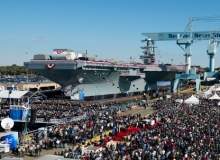
The culmination of four years’ work came on 9 November when the aircraft carrier was christened in front of thousands of assembled workers and VIP guests.
This included the daughter of the carrier’s namesake, former US president Gerald Ford, who smashed the ceremonial bottle of champagne on the hull.
The sheer scale and speed of the carrier is shown in a new time lapse video released by Huntington Ingalls Industries (see above).
Through rain, sunshine and even the occasional snow storm, the video shows the huge steel parts slowly come together to form the recognisable shape of an aircraft carrier.
The four year process saw electricians, welders, crane operators and engineers work 24 hours a day, seven days a week, to finish their immense build.
The cost of a new-generation supercarrier
But this engineering marvel has come at a price. Construction costs are reported to have increased by 22% and are now thought to be in the region of $12.8bn. The ship is also only 70% complete and delivery has been delayed until 2016.
Once delivered and in operational service, the daily operating cost will be several million dollars.
But the USS Gerald R. Ford could be in service for another century, playing a pivotal role for the US while it patrols across the globe. With at least two more carriers planned, the US Navy’s global supremacy will be guaranteed for the foreseeable future.
Related content
Rethinking defence: Naval modernisation in South America
The Brazilian Navy has taken delivery of its third and final multimillion dollar Offshore Patrol Vessel from BAE Systems.
The P-8 Poseidon adventure: Delivering a new-era of maritime aircraft
The US Navy’s new maritime warfare aircraft, the Boeing P-8A Poseidon, will reach Initial Operational Capability by the end of year.


.gif)

